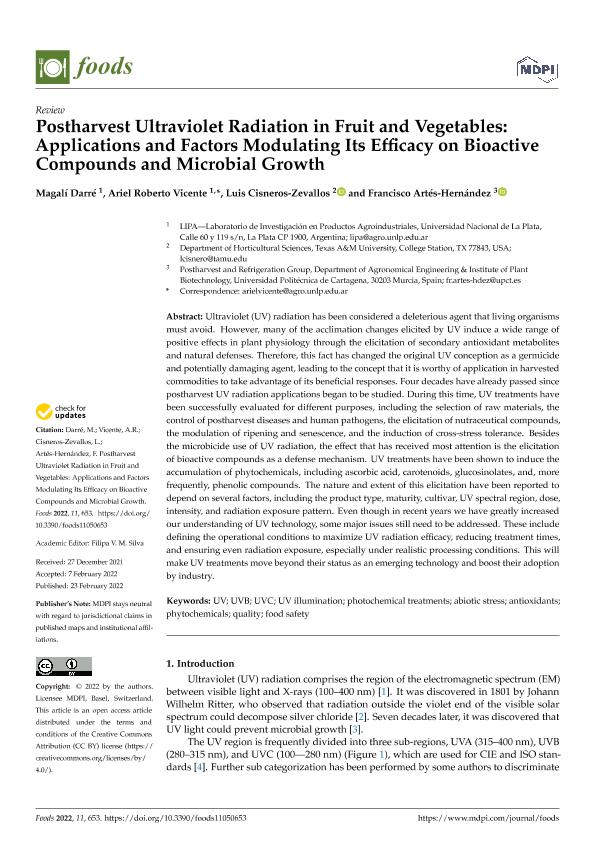Artículo
Postharvest Ultraviolet Radiation in Fruit and Vegetables: Applications and Factors Modulating Its Efficacy on Bioactive Compounds and Microbial Growth
Fecha de publicación:
02/2022
Editorial:
Multidisciplinary Digital Publishing Institute
Revista:
Foods
e-ISSN:
2304-8158
Idioma:
Inglés
Tipo de recurso:
Artículo publicado
Clasificación temática:
Resumen
Ultraviolet (UV) radiation has been considered a deleterious agent that living organisms must avoid. However, many of the acclimation changes elicited by UV induce a wide range of positive effects in plant physiology through the elicitation of secondary antioxidant metabolites and natural defenses. Therefore, this fact has changed the original UV conception as a germicide and potentially damaging agent, leading to the concept that it is worthy of application in harvested commodities to take advantage of its beneficial responses. Four decades have already passed since postharvest UV radiation applications began to be studied. During this time, UV treatments have been successfully evaluated for different purposes, including the selection of raw materials, the control of postharvest diseases and human pathogens, the elicitation of nutraceutical compounds, the modulation of ripening and senescence, and the induction of cross-stress tolerance. Besides the microbicide use of UV radiation, the effect that has received most attention is the elicitation of bioactive compounds as a defense mechanism. UV treatments have been shown to induce the accumulation of phytochemicals, including ascorbic acid, carotenoids, glucosinolates, and, more frequently, phenolic compounds. The nature and extent of this elicitation have been reported to depend on several factors, including the product type, maturity, cultivar, UV spectral region, dose, intensity, and radiation exposure pattern. Even though in recent years we have greatly increased our understanding of UV technology, some major issues still need to be addressed. These include defining the operational conditions to maximize UV radiation efficacy, reducing treatment times, and ensuring even radiation exposure, especially under realistic processing conditions. This will make UV treatments move beyond their status as an emerging technology and boost their adoption by industry.
Archivos asociados
Licencia
Identificadores
Colecciones
Articulos(CIDCA)
Articulos de CENTRO DE INV EN CRIOTECNOLOGIA DE ALIMENTOS (I)
Articulos de CENTRO DE INV EN CRIOTECNOLOGIA DE ALIMENTOS (I)
Citación
Darré, Magalí; Vicente, Ariel Roberto; Cisneros Zevallos, Luis; Artés Hernández, Francisco; Postharvest Ultraviolet Radiation in Fruit and Vegetables: Applications and Factors Modulating Its Efficacy on Bioactive Compounds and Microbial Growth; Multidisciplinary Digital Publishing Institute; Foods; 11; 5; 2-2022; 1-19
Compartir
Altmétricas




